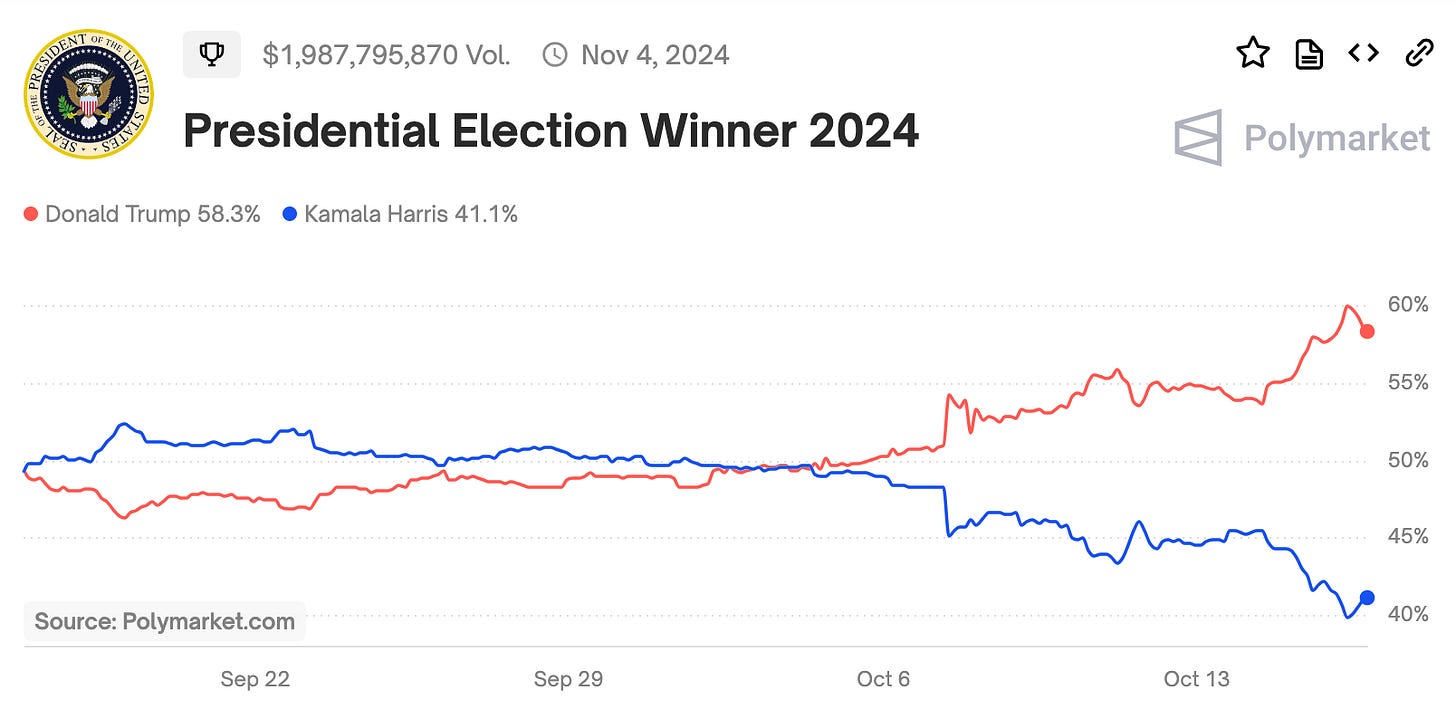The French Connection
Over the past week or so, a sizable gap has opened up between prediction markets and statistical models referencing the outcome of the November election.
The first signs of a break appeared on the morning of October 7, when there was a sudden rise in the price of the Trump contract on Polymarket that could not be traced to any new public information:
Further increases followed and the contract hit a peak above 60 today before pulling back to about 58. The corresponding contract on Kalshi made a similar but more muted journey, starting a couple of days later and peaking at 57:
Meanwhile, models have been relatively stable, some of them even moving slightly in the opposite direction. At the moment FiveThirtyEight gives Harris a 56 percent chance of winning, the Economist gives her 54 percent, and Silver Bulletin sees the race as dead even.
The Polymarket moves were initially traced to the activity of a single account that currently holds 17 million shares in the headline contract, and has staked almost 13 million dollars betting on Trump to win the election, the popular vote, and a number of individual states. It now appears that there are four separate accounts (possibly linked to a single trader) using very similar strategies, all placing large limit orders that effectively set a floor on the price of Trump contracts. Taken together, these accounts have poured 25 million dollars into the market so far, and have already had a significant price impact.
It appears that these traders (or single trader using separate accounts) have a French connection. At least one of them claims to be a finance professional who lived in New York between 2000 and 2006, goes by the name of Michel, has no preference over the election outcome, and thinks that the headline Trump contract should be priced at 75 based on polls, statistics, and a “history of overperformance.” Given certain uses of grammar and idiom, Michel does appear to be a native French speaker.
But if the Polymarket price is being driven by deep-pocketed foreign residents, why has the price on Kalshi moved in tandem? Kalshi allows trading only by confirmed US nationals and has a long list of other prohibitions, none of which are binding on crypto-based Polymarket.
The answer is simple—as long as there are a few large traders active on both markets, any significant price disparity gives rise to an opportunity for arbitrage. If you can bet against Trump for 40¢ on Polymarket and against Harris for 50¢ on Kalshi, you can buy a dollar for 90¢ by betting against both. There are some risks, for instance due to contracts referencing slightly different events and being subject to different rules for resolution. But these risks are generally perceived to be negligible, and prices across exchanges don’t usually deviate from each other too sharply for very long.
An exception to this phenomenon is PredictIt, which is required by regulators to prevent any trader from risking more than $850 on any given contract. This limits the potential for arbitrage, and allows this market to be somewhat insulated from activity elsewhere.
Many observers dismiss PredictIt because of low volumes, a distortionary fee structure, and constraints on participation and position size. But some of these constraints actually make it more reliable as a forecasting mechanism. Preventing a single trader or small group from dominating markets allows for a broader range of opinions to be reflected in prices, and better harnesses the wisdom of crowds.
One interesting development today was the market reaction to the exposure of the French connection. Prior to this, traders had to contemplate the possibility that price changes were being driven by someone with privileged access to inside information. Betting against such an individual would have been extremely risky—this is the problem of adverse selection faced routinely by market makers. The revelation that the market was being moved by foreign nationals with strong views but no particular informational advantage has opened the door to trading by those who disagree, and led to a modest but noticeable reversal of the price trend.
Models face plenty of difficulties in uncharted waters, but at least they remain anchored by data. Markets, meanwhile, can become untethered from reality from time to time. Predicting price movements is always a hazardous undertaking, but my guess is that markets and models will come into closer alignment over the next few days.




The argument for multiple markets with different rules as a way to help triangulate information inputs seems amenable to formalization (e.g. improving model identifiability in some sort of hierarchical Bayesian model with market-specific likelihood functions; perhaps even using data at the transaction level and per-trader utility function type as a latent variable, that sort of thing). Is there prior and/or ongoing work in this direction?
Love the police work.